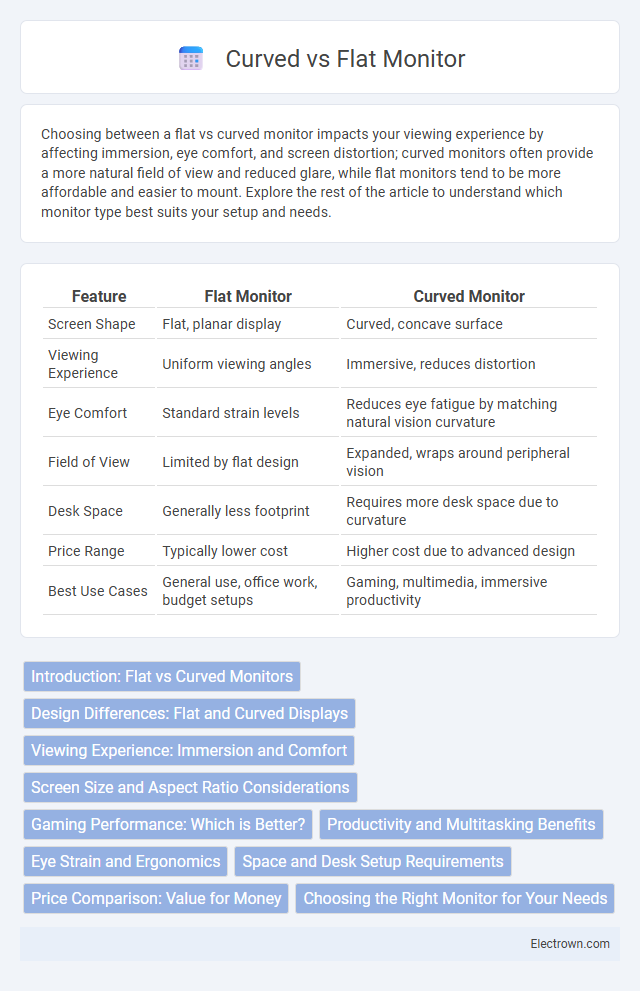Choosing between a flat vs curved monitor impacts your viewing experience by affecting immersion, eye comfort, and screen distortion; curved monitors often provide a more natural field of view and reduced glare, while flat monitors tend to be more affordable and easier to mount. Explore the rest of the article to understand which monitor type best suits your setup and needs.
Table of Comparison
| Feature | Flat Monitor | Curved Monitor |
|---|---|---|
| Screen Shape | Flat, planar display | Curved, concave surface |
| Viewing Experience | Uniform viewing angles | Immersive, reduces distortion |
| Eye Comfort | Standard strain levels | Reduces eye fatigue by matching natural vision curvature |
| Field of View | Limited by flat design | Expanded, wraps around peripheral vision |
| Desk Space | Generally less footprint | Requires more desk space due to curvature |
| Price Range | Typically lower cost | Higher cost due to advanced design |
| Best Use Cases | General use, office work, budget setups | Gaming, multimedia, immersive productivity |
Introduction: Flat vs Curved Monitors
Flat monitors offer a consistent viewing angle and are generally more affordable, making them ideal for standard workspace setups. Curved monitors enhance immersion by wrapping the display around your field of vision, reducing eye strain and providing a more natural viewing experience. Choosing between flat and curved monitors depends on your preference for visual comfort, screen size, and usage environment.
Design Differences: Flat and Curved Displays
Flat monitors feature a uniform, planar screen surface that provides a consistent viewing angle and straightforward installation. Curved monitors incorporate a concave design that wraps around the viewer's field of vision, enhancing immersion and reducing distortion at the edges. The curvature radius, typically ranging from 1000R to 3000R, influences the degree of visual immersion and ergonomic comfort.
Viewing Experience: Immersion and Comfort
Curved monitors enhance your viewing experience by providing a more immersive field of view that matches the natural curvature of the human eye, reducing distortion and eye strain during extended use. Flat monitors offer consistent image quality across the entire screen, making them ideal for tasks requiring precise color accuracy and straightforward viewing angles. Choosing between flat and curved screens depends on whether immersion and comfort or accuracy and consistency align better with your specific needs.
Screen Size and Aspect Ratio Considerations
Flat monitors typically offer a wider range of screen sizes and aspect ratios, making them versatile for various tasks and desk setups. Curved monitors, while available in larger sizes, often emphasize ultrawide aspect ratios, enhancing immersion and reducing eye strain during extended use. Your choice should align with the intended workspace and whether a panoramic view or standard dimensions best suit your productivity or entertainment needs.
Gaming Performance: Which is Better?
Curved monitors enhance gaming performance by offering a more immersive experience through a wider field of view and reduced distortion at the edges, especially in ultra-wide formats. Flat monitors provide consistent image quality with minimal glare and are often preferred for competitive gaming due to faster refresh rates and lower input lag. For gamers seeking immersive visuals, curved displays are advantageous, while flat monitors excel in speed and precision.
Productivity and Multitasking Benefits
Flat monitors provide consistent viewing angles and reduce distortions, making them ideal for precise tasks and detailed work. Curved monitors enhance immersion and increase screen real estate, allowing for easier multitasking by naturally aligning with your field of vision. Your productivity can improve with a curved monitor as it minimizes eye strain and enables seamless window management across a wider display.
Eye Strain and Ergonomics
Curved monitors reduce eye strain by providing a uniform focal distance, which minimizes the need for constant refocusing and reduces visual fatigue during extended use. Ergonomically, their design promotes a more natural viewing angle, decreasing neck and eye movement compared to flat monitors, which require more frequent head adjustments. Choosing a curved monitor can enhance your comfort and reduce the risk of strain-related discomfort during prolonged screen time.
Space and Desk Setup Requirements
Flat monitors typically require less desk space compared to curved monitors, making them ideal for compact or minimalistic workstations. Curved monitors, with their wider and immersive screens, often need larger desks to accommodate the curvature and extended width, enhancing your viewing experience without sacrificing comfort. When planning your desk setup, consider that curved displays may demand additional clearance to prevent neck strain and optimize visual alignment.
Price Comparison: Value for Money
Flat monitors generally offer better value for money due to their lower price points while still delivering sharp image quality and reliable performance. Curved monitors come at a premium, with prices significantly higher depending on size and curvature, but they enhance immersion and reduce eye strain for gaming or professional use. Your choice should balance budget constraints with specific needs for visual comfort and screen engagement.
Choosing the Right Monitor for Your Needs
Choosing the right monitor depends on your primary use and workspace setup, as flat monitors provide accurate color representation and are ideal for tasks like graphic design and general office work, while curved monitors enhance immersion and reduce eye strain for gaming and multimedia. Consider resolution, screen size, and viewing distance to match your visual comfort and productivity goals. Your decision should balance ergonomic benefits and image quality to optimize your overall experience.
Flat vs Curved Monitor Infographic

 electrown.com
electrown.com